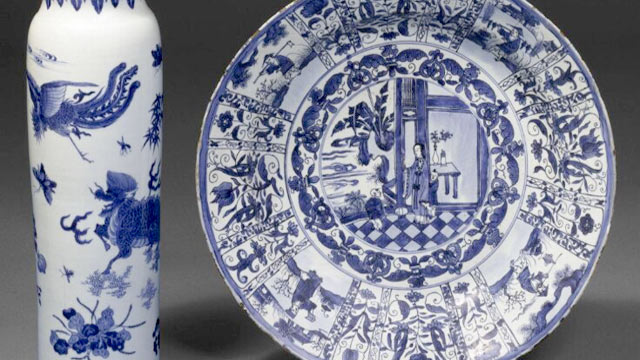In the 13th century, when traffic and information were sparse, Marco Polo, a Venetian, came to China by land and served the Chinese Yuan imperial court from 1275 to 1295. The white Chinese porcelain vases, which he took back to his motherland and which are archived at San Marco Museum in Venice today, are reputed as a symbol of the Chinese vogue that went viral in Europe 300 years later. The Travels of Marco Polo has stirred European’s imagination of China[1] , and also promoted Europe's maritime exploration.
However, before the opening of the new sea route between China and Europe in the 15th century, Chinese porcelains were rarely exported to the European market as a commodity. The trade of Chinese porcelains to Europe was monopolized by Arab merchants, while European merchants could only obtain fewer Chinese porcelains from West Asia and Egypt in the form of intermediary trade. Unlike silk and spices, which were easy to carry and transport, Chinese porcelains were mostly sold locally by means of land transportation because of their fragility and weight. They were closely connected with local culture, after which they were imprinted with local aesthetic characteristics and shipped to Europe. However, Chinese porcelains were not what they had always been. Forerunner of great geographical discoveries as he was, Zheng made seven large-scale ocean voyages during Ming Dynasty from 1405 to 1433, but did not establish direct contact with Europe.
Comparatively, European humanism and capitalism were at an embryo stage. From the 15th century to the 17th century, European fleets represented by Portugal, Spain and the Netherlands carried out sailing explorations in order to seek new trade routes and trading partners as well as develop the capitalism in Europe.
First, Chinese porcelains were shipped to Europe as ballast. However, the European upper class favoured them by virtue of their smooth texture, delicate and hard casing and exquisite emblazonment. European royal nobles and bishops all were keen on owning Chinese porcelains to show off their wealth and status. European royal families’ love to Chinese porcelains did not ease in spite of the fact that they had little understanding of the materials and techniques and far away China. Philip II of Spain (1527-1598) had a collection of 3,000 pieces. Although Europe started importing Chinese porcelains on a big scale, a mysterious atmosphere always clung to these exquisite utensils. At that time, some people in Europe even thought that Chinese porcelains could play an anti-virus effect.
The French doctor Loys Guyon (1527-1617) and Sir Thomas Browne (1605-1682) of England studied Chinese porcelains. Père Francois Xavier d'Entrecolles (1664-1741), a French missionary, was in Jingdezhen, China, for 7 years during the 17th century. In 1712 and 1722, he wrote reports on the details of Chinese porcelains making which he observed and inquired into and mailed them back to the Jesuits in Europe, making it possible for French to imitate porcelains locally.
Already in 1575, Italian Medici Grand Duke Francesco's factory made an attempt to produce porcelains, which was the first imitation recorded in Europe. Such a kind of Medici pottery bottle with blue and white patterns is collected in the Louvre. Both the white glazed blue painted pottery in Delft, the Netherlands, and the Nevers kiln in France have imitated the decorative style of Chinese porcelains. However, in terms of materials, they came in pottery or soft porcelain. The alchemist Bottger did not calcinate the earliest European porcelain at Meissen, Germany until 1709. In this process, the aesthetic taste in Europe had gradually changed. The fashion of loving oriental artifacts had gradually spread from nobles to rich bourgeoisie. As the demand for relatively cheap goods had also become more and more vigorous, porcelains had gradually turned a part of the daily life of the common. The nature of Chinese porcelain had gradually changed from collectibles to daily commodities.
In order to meet the needs of European society, East India Companies in European countries imported a large number of porcelains from China in the 17th and 18th centuries. In China, this kind of porcelain for export was called export-purpose Chinese porcelain.[2] From the change of shape and pattern the export-purpose Chinese porcelains can be roughly classified into traditional styles, hybrid styles and foreign styles.
1. Traditional styles (The shape and decoration of porcelain have not been influenced by foreign styles, and are no different from products on the Chinese market.)
From the opening of the new sea route in the 16th century to the lift of the ban on maritime trade in 1684, it was illegal for Chinese to export porcelains. As per the ban on maritime trade in the Ming Dynasty, non-governmental maritime trade was strictly prohibited, while official tribute trade was allowed with strict restrictions. Foreign countries could only conduct limited official trade with the Ming authorities. Since then, the Qing authorities have repeated the ban on maritime trade. The production and shipment then were at great risks.
Merchants usually purchased Chinese porcelains in Guangzhou and then shipped them abroad from Macao, making the export-purpose Chinese porcelains dominated by traditional Chinese style at this stage. It influenced the early stage of the Chinese style in Europe as well as the reproduction and imitation of Chinese porcelain with soft pottery in Europe. Chinese porcelains were mainly used as daily necessities, such as dishes, bowls, bottles and pots. But there were few ornamental porcelains as well. The decorative patterns mostly came in cloud-dragons, deer, horses, cranes, monkeys, flying butterflies, birds and insects, folding branches and flowers, fairy ladies with babies, city walls with mountains and waters, auspicious characters, etc.
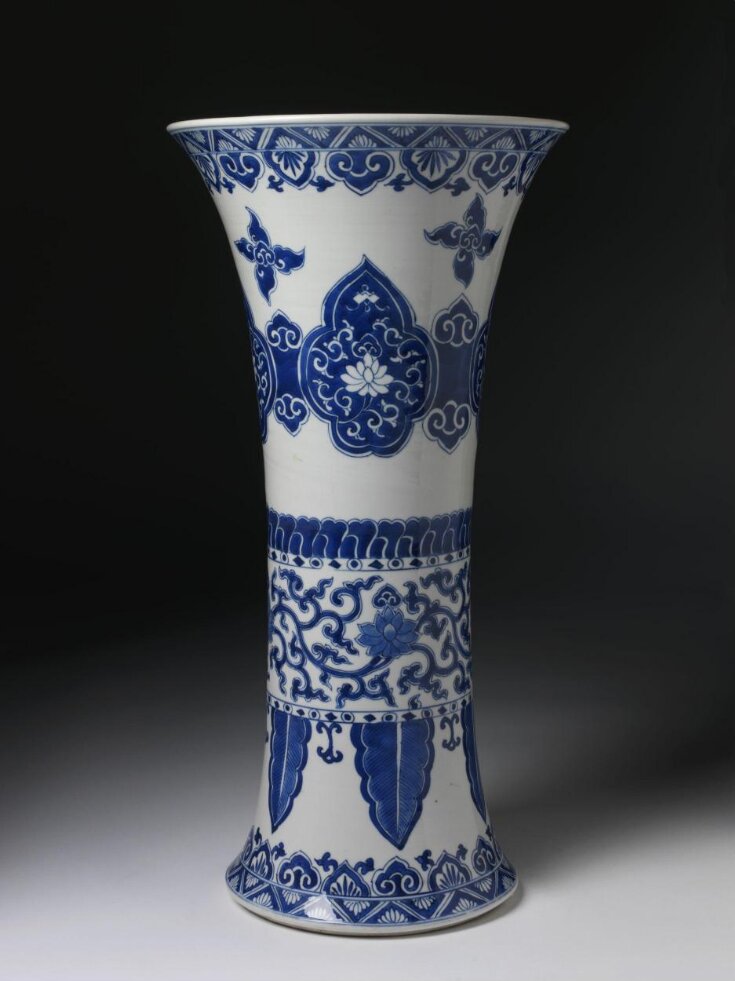
Unknown, Blue and white porcelain vase, 1700-1710, Victoria and Albert Museum London.
The style of blue-and-white porcelains represented the life of the easterners to Europeans. A great number of Chinese porcelains of this kind are recorded in the archives of Dutch East India Company.
On the one hand, few Chinese porcelains were exported to Europe with a higher price; on the other hand, the pure oriental shape made Chinese porcelains deviate from the daily needs of Europeans. For example, easterners’ habit of eating rice and using chopsticks makes bowls the most common utensils in the East, while westerners’ custom of eating bread and using knives and forks has not made bowls, with a deep-walled shape, the mainstream of European tableware by far. Because the typical Chinese tableware consists of fewer parts compared to Western dining habits, Chinese porcelain dishes could only be used for holding cakes and pastries in Europe. For example, porcelain pen containers were used as wine cooler, and porcelain fish tanks were used as flowerpots... Chinese porcelains were constrained in terms of use, and often modified or displayed as ornaments. Therefore, a new style came out in the course of development.
2. Hybrid styles. (Chinese traditional style couples with foreign ornaments and vise versa, or Eastern themes couple with Western ones for hybrid ornaments.)
It is the stage of free transformation of Chinese style porcelains. Among this type, porcelain with traditional Chinese themes, or a mixture of different themes from China and Europe, combined with European shapes is the most representative. Part of the changes in the shape of European porcelain came from metalware, and part from the changes in lifestyle brought about by trade. For example, since the 17th century, Europeans have been importing black tea and coffee from the East and chocolate from Mexico. These hot drinks come brown in color after brewing, and white Chinese porcelains serve as the most suitable drinking utensils. The emergence of new eating habits has promoted the transformation of Chinese porcelain utensils. The Dutch enlarged the size of traditional Chinese small teacups and designed a lug.[3] Kraak porcelain[4] and Mandarin style were the most representative.
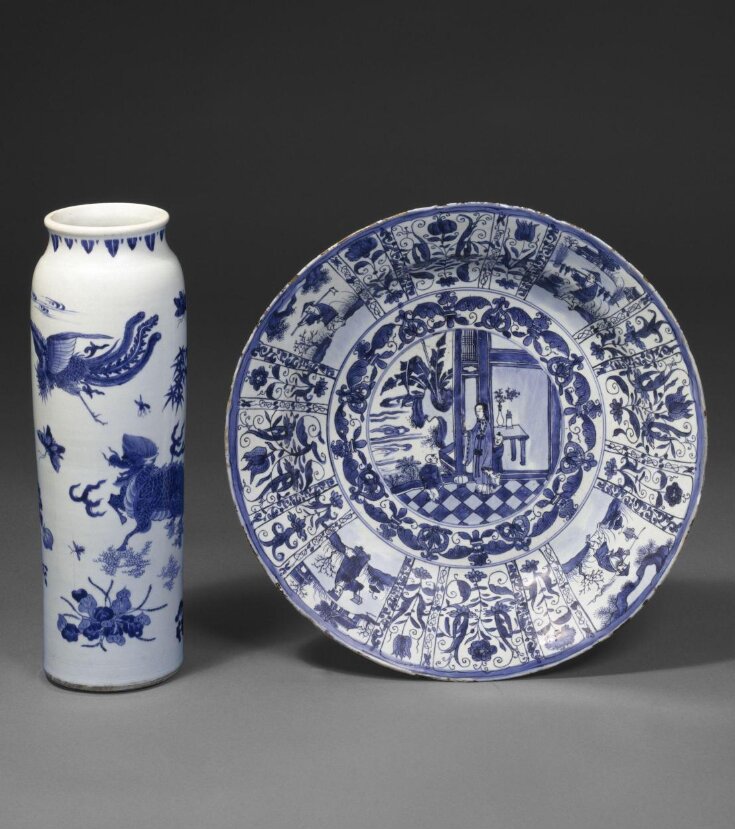
Unknown, Dish, ca. 1635-1655, Kraak Porcelain, Diameter: 47,5 cm, Bibliographic Reference: Clunas, Craig (ed.). Chinese Export Art and Design. London: Victoria and Albert Museum, 1987, p. 38, fig. 16.
Kraak porcelain is a form of blue and white porcelain exported from Wanli Period of Ming Dynasty (1573-1620) to early Qing Dynasty. It was mainly shaped in dishes, bottles and bowls, and represented by trimmed patterns. These patterns came round, diamond-shaped and lotus petal-shaped, with designs of flowers, birds, fish and insects, landscapes, figures and auspicious mascots commonly seen in Chinese porcelains. Later, exotic religious myths and social life themes appeared in trimmed patterns. In terms of techniques, the traditional way of drawing the outline of the pattern on the surface of the porcelain body with a writing brush and then filling it in with color was adopted. Kraak porcelain is a kind of export-purpose porcelain with the largest quantity and the longest influence period of more than 100 years. After that, blue and white porcelain in Kangxi Period (1662-1722) of Qing Dynasty came in western rendering techniques in drawing, showing a maximum of eight or nine color gradations on the porcelain body. And it drew much popularity among westerners.
The word “Mandarin” was a name for Chinese officials when Portuguese traded with Chinese merchants in the 17th century. In the 17th and 18th centuries, many missionaries and painters came to China and recorded their experiences there, including their life and work with Chinese officials in addition to preaching.
Most of the decorative patterns depicted the life of officials and wealthy merchants in Qing Dynasty, who enjoyed a rich and leisurely family life. These descriptions and landscape paintings further aroused European‘s curiosity about live in China. Aiming at this market opportunity, Guangzhou Porcelain Workshop launched Mandarin style products for European and American markets. Some patterns use the perspective technology of European oil paintings, and the expressions of the characters are vivid, which conforms to the aesthetic orientation of Europeans. These patterns presented a desirable pastoral oriental atmosphere for westerners. Playing in picturesque courtyard gardens, hunting in enchanting springtime, harmonious coexistence between human beings and nature, and vivid home life scenes embodied elegant Chinese costumes, fascinating home decoration, exquisite garden scenes, and charming family happiness. These themes greatly satisfied Europeans’ curiosity and yearning for the East.

Unknown, Three Vases, 1700-1720, Procelain, Jingdezhen, Staatliche Kunstsammlungen Dresden.
3. Foreign styles. (Chinese porcelains satisfying the requirements of European merchants in terms of shapes and patterns, calcined elaborately to serve European consumers’ needs. Most of the patterns were drawn in strict accordance with the prints and patterns as required by customers, so they were usually called custom-made porcelains.)
One type was produced in the 17th century. Since Europe had not yet mastered the technology of porcelain-making, Chinese porcelain workers imitated the pottery of European style according to the requirements of European merchants. Chinese Porcelain competed with European pottery in this way and earned a lot of silver used as currency.
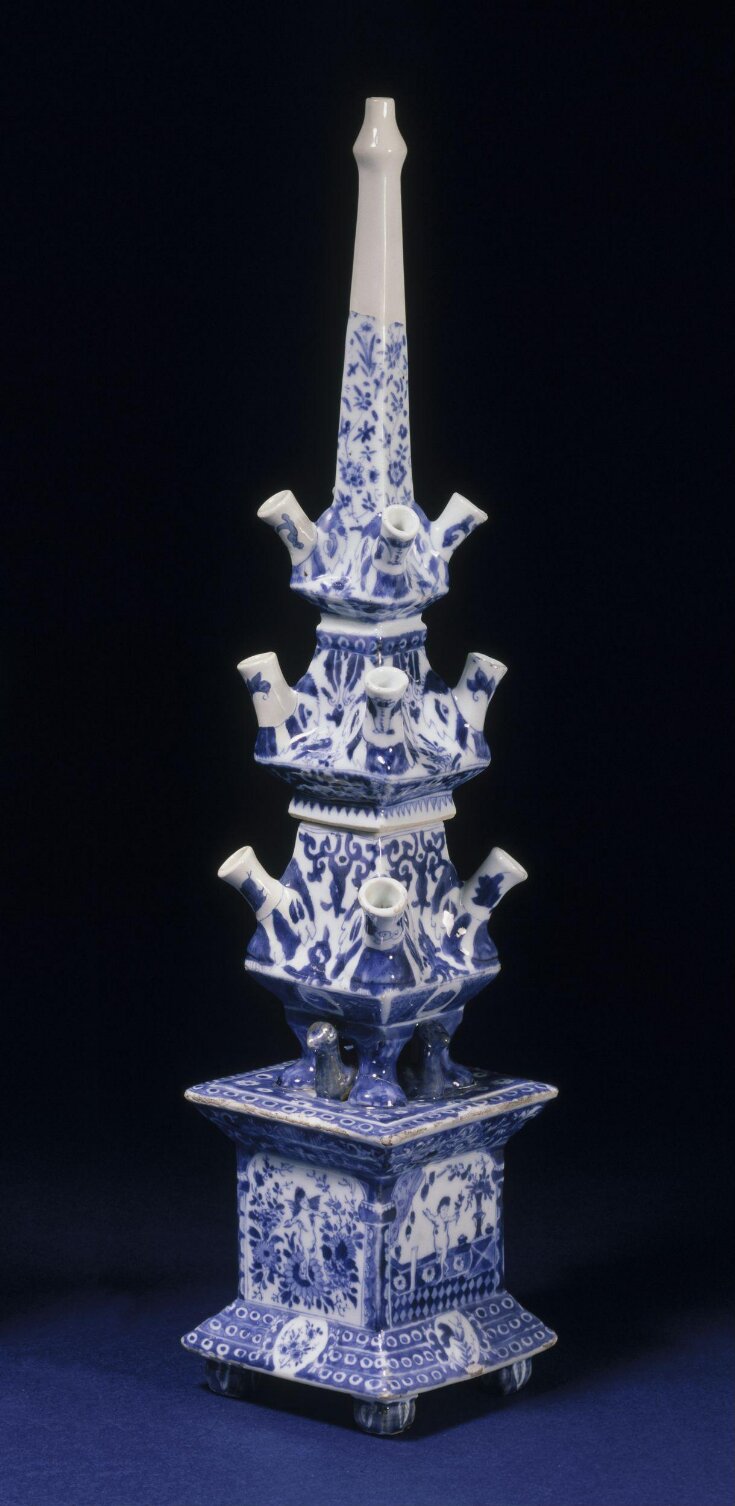
Unknown, Vase with Angel, 1700, Porcelain, H: 36cm, Victoria and Albert Museum London. Bibliographic Reference: Clunas, Craig (ed.). Chinese Export Art and Design. London: Victoria and Albert Museum, 1987, p. 60, fig. 40.
Another type emerged when the Chinese style in the West reached its peak in the 18th century and Chinese characters and landscapes imagined by Westerners appeared in the patterns. The pictures are humorous and interesting, while the number is quite limited. In addition, there were porcelain carvings, figures and animals.
The pattern was typically formed by heraldry (the special signs of European and American aristocratic guilds, groups, etc. In the 18th century, China sold up to 600,000 kinds of heraldry porcelain to Europe). In addition, characters (out of Greek or Roman fairy tales, the Bible, European customs-based sketches), ships, landscapes, flowers, etc. used to be popular themes among Europeans. Besides, European living habits were taken into consideration in terms of modeling.
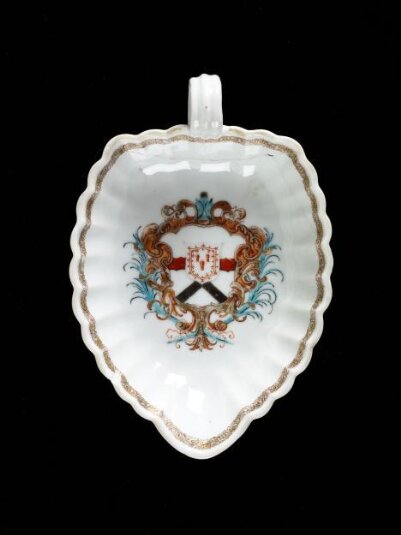
Unknown, Souceboat, ca. 1740, Porcelain, L: 18,4cm, Victoria and Albert Museum London. Bibliographic Reference: Howard, David Santuary. Chinese Armorial Porcelain. London: Faber and Faber Limited, 1974, p. 295.
Apart from blue and white, multicolored and famille rose ones were among this kind of style. Because of the higher cost, longer period of capital occupation, more complicated procedures and greater commercial risks, this variety did not turn a mainstream among export-purpose Chinese porcelains in spite of their distinctive features. Especially in 1769, the first production line of British Wedgwood Porcelain Plant rolled off, when European porcelain production began to leap from the handicraft era to the industrial era. Since then, importing Chinese porcelains has grown unprofitable, and the porcelains in Chinese style turned gradually out of date.
In the course of trade development for nearly 300 years from the 16th century to 19th century, from “Made in China” to “Making Chinese Porcelains”, the Chinese vogue going viral in Europe represented a process of Europeanization of Chinese cultural practices. In this process, lacquerware, woven carpets, clothing, furniture, wallpaper and garden architecture were as well used for reference, quotation and modification in Europe, and finally integrated into the social context of Europe, influencing and even changing the artistic outlook of Europe. Nowadays, the shortened distance and accessible information across the world enable us to see the diversity of cultures more quickly and accurately. More possibilities for cultural exchanges will definitely be springing up in the future.
FOOTNOTES
[1] China in the 13th-19th centuries was only a Far East country geographically along with India, Southeast Asia, South Korea and Japan
[2] Due to the limited space, the export-purpose Chinese porcelain in this paper refers specifically to the exported ones to Europe.
[3] Lin Lin's, Research on Porcelain Trade of Dutch East India Company in the 17th-18th Centuries, pp 31-34.
[4] Its name probably originated from Portugal Caraack, meaning “giant merchant ship”.
REFERENCES
- WangYong, A History of Art Exchange between China and Abroad, Beijing, 2013
- Shanggang, A new compilation of the history of Chinese arts and crafts, Higher Education Press , 2007
- Etiemble, L’Europe Chinoise. The Commercial Press, Beijing, 2013
- Liwei, Through the silk Road, Beijing, 2018
- Hugh Honour,Chinoiserie: The vision of Cathay, Peking University Press, 2017

